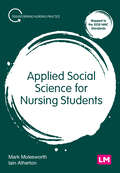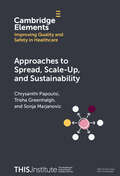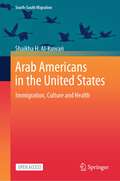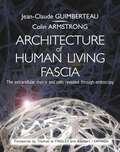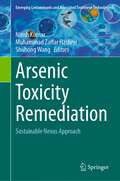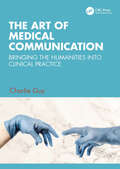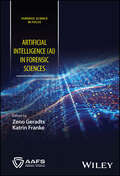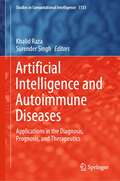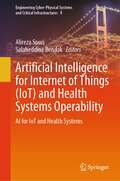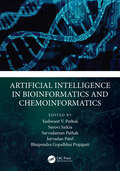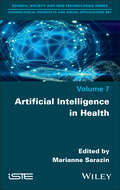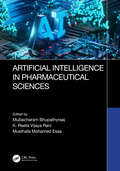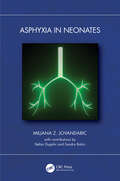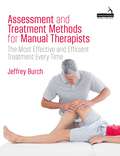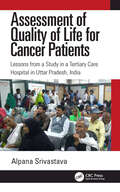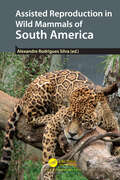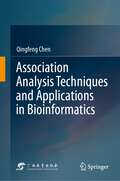- Table View
- List View
Applied Social Science for Nursing Students (Transforming Nursing Practice Series)
by Mark Molesworth Iain AthertonWhat are the social sciences and how are they relevant to nursing? How can I apply them to my practice? This book introduces the essential social science that you need in order to register and practice effectively as a nurse. Contributions from the social sciences enable you to better understand the world view of your patients and service users, as well as the wider social, cultural and political landscape in which they live and you provide care. This book will help you apply this knowledge to your everyday practice. Be it providing holistic person-centred care, advocating for your patients and their communities, or contributing to service improvement, understanding the social sciences is key to a nursing career that truly makes a difference. Key features: - Fully mapped to the NMC standards of proficiency for registered nurses (2018) - Explores social science’s contribution to key aspects of your study including sociology, psychology, research, and health promotion - Case studies, activities and student insights illustrate theory and concepts in real life nursing practice
Approaches to Spread, Scale-Up, and Sustainability (Elements of Improving Quality and Safety in Healthcare)
by null Chrysanthi Papoutsi null Trisha Greenhalgh null Sonja MarjanovicFew interventions that succeed in improving healthcare locally end up becoming spread and sustained more widely. This indicates that we need to think differently about spreading improvements in practice. Drawing on a focused review of academic and grey literature, the authors outline how spread, scale-up, and sustainability have been defined and operationalised, highlighting areas of ambiguity and contention. Following an overview of relevant frameworks and models, they focus on three specific approaches and unpack their theoretical assumptions and practical implications: the Dynamic Sustainability Framework, the 3S (structure, strategy, supports) infrastructure approach for scale-up, and the NASSS (non-adoption, abandonment, and challenges to scale-up, spread, and sustainability) framework. Key points are illustrated through empirical case narratives and the Element concludes with actionable learning for those engaged in improvement activities and for researchers. This title is also available as Open Access on Cambridge Core.
Arab Americans in the United States: Immigration, Culture and Health (International Perspectives on Migration)
by Shaikha H. Al-KuwariThis open access book provides a unique perspective on the relationship between immigration, culture, and health. It presents a cross-cultural perspective between culture and illness. It touches upon identity struggles, the notion of not feeling “safe, understood, accepted,” and its relation to Arab American health. The book provides a comprehensive review of the history of Muslims in America and discusses better healthcare services for chronic illness—diabetes. It provides an ethnographic framework for building cultural belief models of illness, which helps study any illness among any population. It is a must-read for everyone interested in understanding the relationship among culture, health, and immigration, as well as the importance of building cultural belief models of illness and their possible impact on providing better healthcare services. The book is of interest to scholars, caregivers, and those living with diabetes.
Architecture of Human Living Fascia: The Extracellular Matrix and Cells Revealed Through Endoscopy
by Jean Claude Guimberteau Colin ArmstrongThis unique book illustrates the structure of the fascia in the living human being. Dr Guimberteau's photographs provide a detailed account of fascial architecture. The accompanying text explains what the photographs mean, clarifies the importance of the fascia, and sets out the implications of these findings for everyday therapeutic practice.This beautifully illustrated book provides an introduction to Dr Guimberteau's groundbreaking work. He is the first person to publish video "movies" showing the structure of the fascia and how the fascia responds to. Based on what can be seen he has developed his own concept of the multifibrillar structural organisation of the body, wherein the "microvacuole" is the basic functional unit. His films confirm the continuity of fibres throughout the body thereby seeming to confirm the tensegrity theory, which provides the basis of many manual therapy and bodywork teachings. His work ties in with that of Donald Ingber on tensegrity within the cytoskeleton, and adds to the evidence linking the cytoskeleton to the extracellular matrix as described by james Oschman. The book and videos provide, for the first time, an explanatory introduction and explanation of these theories and link them to the visual evidence shown in the video. This material will be highly valued by osteopaths, massage therapists, chiropractors and others as it provides part of the scientific underpinning of their techniques, as well as an explanation of what is happening when they use those techniques to treat their clients.So Guimberteau's material confirms what manual therapists already believed but didn't fully understand. He has provided an explanation of how fascial layers slide over each other and how adjacent structures can move independently in different directions and at different speeds while maintaining the stability of the surrounding tissues.
Arsenic Toxicity Remediation: Sustainable Nexus Approach (Emerging Contaminants and Associated Treatment Technologies)
by Nitish Kumar Muhammad Zaffar Hashmi Shuhong WangArsenic contamination in drinking water and crops is a major health issue in many countries worldwide, threatening the health of millions of people due to arsenic’s toxicity and carcinogenicity. This edited volume brings together a diverse group of environmental science, sustainability and health researchers to address the challenges posed by arsenic contamination. The book sheds light on this global environmental issue and proposes solutions to aquatic contamination through multi-disciplinary sustainable approaches and case studies from different parts of the world. The chapters contained here present the status quo in different parts of the world and provide essential information on arsenic exposure risks for humans as well as possible measures for tackling arsenic poisoning. The mechanisms of arsenic uptake, translocation and distribution in plants and grains are also explained. In closing, the book reviews a variety of prospective sustainable solutions to the problem of arsenic accumulation in soil and water. The book is comprised of three sections. The first section describes the routes of exposure to environmental arsenic and its transport in soil and aquatic ecosystems. The second section explains the health risks linked to arsenic exposure in food and the environment. The third section addresses sustainable arsenic contamination mitigation strategies using the potential applications of recent biological technology such as biotechnology, bioremediation, phytoremediation, biochar, absorbent, genetic engineering, and nanotechnology approaches. The book is intended for a broad audience including researchers, scientists, and readers with diverse backgrounds.
The Art of Medical Communication: Bringing the Humanities into Clinical Practice
by Charlie GuyThe field of medical humanities is growing rapidly and offers many valuable insights for medical education generally and for enhancing and improving communication specifically. Through practical and thought-provoking examples, this innovative new text demonstrates how engaging with the arts and humanities can benefit the work of doctors and make them better, more effective practitioners with a focus on achieving this through better communication and by stimulating self-reflection. Key features: Utilises modern and familiar examples, including case studies, to illustrate and explore language and communication skill deployment in a variety of given scenarios Reflects the increasing use of online consultation and the associated importance of ensuring effective communication in virtual settings Describes several models for reflective practice Supported by a selection of eResources to enhance reader experience and understanding; visit www.routledge.com/9781032272726 This new book is written specifically for medical students, junior doctors and medical educators looking to develop or teach communication skills. It will instil and support the background understanding of the role, need and ongoing requirement for humanities engagement in self-development and reflection to enhance and improve the experience of both the practitioner and the patient.
The Art of Medical Communication: Bringing the Humanities into Clinical Practice
by Charlie GuyThe field of medical humanities is growing rapidly and offers many valuable insights for medical education generally and for enhancing and improving communication specifically. Through practical and thought-provoking examples, this innovative new text demonstrates how engaging with the arts and humanities can benefit the work of doctors and make them better, more effective practitioners with a focus on achieving this through better communication and by stimulating self-reflection. Key features: Utilises modern and familiar examples, including case studies, to illustrate and explore language and communication skill deployment in a variety of given scenarios Reflects the increasing use of online consultation and the associated importance of ensuring effective communication in virtual settings Describes several models for reflective practice Supported by a selection of eResources to enhance reader experience and understanding; visit www.routledge.com/9781032272726 This new book is written specifically for medical students, junior doctors and medical educators looking to develop or teach communication skills. It will instil and support the background understanding of the role, need and ongoing requirement for humanities engagement in self-development and reflection to enhance and improve the experience of both the practitioner and the patient.
Artificial Intelligence (Forensic Science in Focus)
by Zeno Geradts Katrin FrankeARTIFICIAL INTELLIGENCE (AI) IN FORENSIC SCIENCES Foundational text for teaching and learning within the field of Artificial Intelligence (AI) as it applies to forensic science Artificial Intelligence (AI) in Forensic Sciences presents an overview of the state-of-the-art applications of Artificial Intelligence within Forensic Science, covering issues with validation and new crimes that use AI; issues with triage, preselection, identification, argumentation and explain ability; demonstrating uses of AI in forensic science; and providing discussions on bias when using AI. The text discusses the challenges for the legal presentation of AI data and interpretation and offers solutions to this problem while addressing broader practical and emerging issues in a growing area of interest in forensics. It builds on key developing areas of focus in academic and government research, providing an authoritative and well-researched perspective. Compiled by two highly qualified editors with significant experience in the field, and part of the Wiley — AAFS series ‘Forensic Science in Focus’, Artificial Intelligence (AI) in Forensic Sciences includes information on: Cyber IoT, fundamentals on AI in forensic science, speaker and facial comparison, and deepfake detection Digital-based evidence creation, 3D and AI, interoperability of standards, and forensic audio and speech analysis Text analysis, video and multimedia analytics, reliability, privacy, network forensics, intelligence operations, argumentation support in court, and case applications Identification of genetic markers, current state and federal legislation with regards to AI, and forensics and fingerprint analysis Providing comprehensive coverage of the subject, Artificial Intelligence (AI) in Forensic Sciences is an essential advanced text for final year undergraduates and master’s students in forensic science, as well as universities teaching forensics (police, IT security, digital science and engineering), forensic product vendors and governmental and cyber security agencies.
Artificial Intelligence (Forensic Science in Focus)
by Zeno Geradts Katrin FrankeARTIFICIAL INTELLIGENCE (AI) IN FORENSIC SCIENCES Foundational text for teaching and learning within the field of Artificial Intelligence (AI) as it applies to forensic science Artificial Intelligence (AI) in Forensic Sciences presents an overview of the state-of-the-art applications of Artificial Intelligence within Forensic Science, covering issues with validation and new crimes that use AI; issues with triage, preselection, identification, argumentation and explain ability; demonstrating uses of AI in forensic science; and providing discussions on bias when using AI. The text discusses the challenges for the legal presentation of AI data and interpretation and offers solutions to this problem while addressing broader practical and emerging issues in a growing area of interest in forensics. It builds on key developing areas of focus in academic and government research, providing an authoritative and well-researched perspective. Compiled by two highly qualified editors with significant experience in the field, and part of the Wiley — AAFS series ‘Forensic Science in Focus’, Artificial Intelligence (AI) in Forensic Sciences includes information on: Cyber IoT, fundamentals on AI in forensic science, speaker and facial comparison, and deepfake detection Digital-based evidence creation, 3D and AI, interoperability of standards, and forensic audio and speech analysis Text analysis, video and multimedia analytics, reliability, privacy, network forensics, intelligence operations, argumentation support in court, and case applications Identification of genetic markers, current state and federal legislation with regards to AI, and forensics and fingerprint analysis Providing comprehensive coverage of the subject, Artificial Intelligence (AI) in Forensic Sciences is an essential advanced text for final year undergraduates and master’s students in forensic science, as well as universities teaching forensics (police, IT security, digital science and engineering), forensic product vendors and governmental and cyber security agencies.
Artificial Intelligence and Autoimmune Diseases: Applications in the Diagnosis, Prognosis, and Therapeutics (Studies in Computational Intelligence #1133)
by Khalid Raza Surender SinghThe book provides an overview of various autoimmune disorders and how artificial intelligence (AI) and machine learning will be used for the diagnosis, prognosis, and treatment of these disorders. AI algorithms are used to create synthetic patient populations with the properties of actual patient cohorts, build personalized predictive models of drug combinations and unravel complex relationships between diet, microbiome, and genetic line-up to determine the comparative treatment response. The book highlights clinical applications and challenges of AI for the diagnosis and treatment/management of autoimmune disorders which includes Rheumatoid Arthritis (RA), Multiple Sclerosis (MS), Type I Diabetes, Psoriatic Arthritis (PsA), and other critical diseases.
Artificial Intelligence for Internet of Things: AI for IoT and Health Systems (Engineering Cyber-Physical Systems and Critical Infrastructures #8)
by Alireza Souri Salaheddine BendakIoTHIC-2023 is a multidisciplinary, peer-reviewed international conference on Internet of Things (IoT) and healthcare systems with Artificial Intelligence (AI) techniques such as data mining, machine learning, image processing, and meta-heuristic algorithms. The AI-based techniques are applied on many fields of healthcare systems, including predicting and detecting diseases in hospitals, clinics, smart health monitoring systems, surgery, medical services, and etc.
Artificial Intelligence in Bioinformatics and Chemoinformatics
by Yashwant V. PathakThe authors aim to shed light on the practicality of using machine learning in finding complex chemoinformatics and bioinformatics applications as well as identifiying AI in biological and chemical data points. The chapters are designed in such a way that they highlight the important role of AI in chemistry and bioinformatics particularly for the classification of diseases, selection of features and compounds, dimensionality reduction and more. In addition, they assist in the organization and optimal use of data points generated from experiments performed using AI techniques. This volume discusses the development of automated tools and techniques to aid in research plans. Features Covers AI applications in bioinformatics and chemoinformatics Demystifies the involvement of AI in generating biological and chemical data Provides an Introduction to basic and advanced chemoinformatics computational tools Presents a chemical biology based toolset for artificial intelligence usage in drug design Discusses computational methods in cancer, genome mapping, and stem cell research
Artificial Intelligence in Bioinformatics and Chemoinformatics
by Yashwant Pathak Surovi Saikia Sarvadaman Pathak Jayvadankumar Patel Bhupendra Gopalbhai PrajapatiThe authors aim to shed light on the practicality of using machine learning in finding complex chemoinformatics and bioinformatics applications as well as identifiying AI in biological and chemical data points. The chapters are designed in such a way that they highlight the important role of AI in chemistry and bioinformatics particularly for the classification of diseases, selection of features and compounds, dimensionality reduction and more. In addition, they assist in the organization and optimal use of data points generated from experiments performed using AI techniques. This volume discusses the development of automated tools and techniques to aid in research plans. Features Covers AI applications in bioinformatics and chemoinformatics Demystifies the involvement of AI in generating biological and chemical data Provides an Introduction to basic and advanced chemoinformatics computational tools Presents a chemical biology based toolset for artificial intelligence usage in drug design Discusses computational methods in cancer, genome mapping, and stem cell research
Artificial Intelligence in Health
by Marianne SarazinUndeniable, inescapable, exhilarating and breaking free from the exclusive domain of science, artificial intelligence has become our main preoccupation. A major generator of new mathematical thinking, AI is the result of easy access to information and data, as facilitated by computer technology. Big Data has come to be seen as an unlimited source of knowledge, the use of which is still being fully explored, but its industrialization has swiftly followed in the footsteps of mathematicians; today's tools are increasingly designed to replace human beings, which comes with social and philosophical consequences. Drawing on examples of scientific work and the insights of experts, this book offers food for thought on the consequences and future of AI technology in education, health, the workplace and aging.
Artificial Intelligence in Health
by Marianne SarazinUndeniable, inescapable, exhilarating and breaking free from the exclusive domain of science, artificial intelligence has become our main preoccupation. A major generator of new mathematical thinking, AI is the result of easy access to information and data, as facilitated by computer technology. Big Data has come to be seen as an unlimited source of knowledge, the use of which is still being fully explored, but its industrialization has swiftly followed in the footsteps of mathematicians; today's tools are increasingly designed to replace human beings, which comes with social and philosophical consequences. Drawing on examples of scientific work and the insights of experts, this book offers food for thought on the consequences and future of AI technology in education, health, the workplace and aging.
Artificial intelligence in Pharmaceutical Sciences
by Mullaicharam Bhupathyraaj Reeta Vijaya Rani, K. Musthafa Mohamed EssaThis cutting-edge reference book discusses the intervention of artificial intelligence in the fields of drug development, modified drug delivery systems, pharmaceutical technology, and medical devices development. This comprehensive book includes an overview of artificial intelligence in pharmaceutical sciences and applications in the drug discovery and development process. It discusses the role of machine learning in the automated detection and sorting of pharmaceutical formulations. It covers nanosafety and the role of artificial intelligence in predicting potential adverse biological effects. FEATURES Includes lucid, step-by-step instructions to apply artificial intelligence and machine learning in pharmaceutical sciences Explores the application of artificial intelligence in nanosafety and prediction of potential hazards Covers application of artificial intelligence in drug discovery and drug development Reviews the role of artificial intelligence in assessment of pharmaceutical formulations Provides artificial intelligence solutions for experts in the pharmaceutical and medical devices industries This book is meant for academicians, students, and industry experts in pharmaceutical sciences, medicine, and pharmacology.
Artificial intelligence in Pharmaceutical Sciences
by Mullaicharam Bhupathyraaj K. Reeta Vijaya Rani Musthafa Mohamed EssaThis cutting-edge reference book discusses the intervention of artificial intelligence in the fields of drug development, modified drug delivery systems, pharmaceutical technology, and medical devices development. This comprehensive book includes an overview of artificial intelligence in pharmaceutical sciences and applications in the drug discovery and development process. It discusses the role of machine learning in the automated detection and sorting of pharmaceutical formulations. It covers nanosafety and the role of artificial intelligence in predicting potential adverse biological effects. FEATURES Includes lucid, step-by-step instructions to apply artificial intelligence and machine learning in pharmaceutical sciences Explores the application of artificial intelligence in nanosafety and prediction of potential hazards Covers application of artificial intelligence in drug discovery and drug development Reviews the role of artificial intelligence in assessment of pharmaceutical formulations Provides artificial intelligence solutions for experts in the pharmaceutical and medical devices industries This book is meant for academicians, students, and industry experts in pharmaceutical sciences, medicine, and pharmacology.
Asphyxia in Neonates
by Miljana Z. JovandaricIn severe asphyxia, lipid peroxidation occurs. Neonatal lipid concentration may indicate the severity of asphyxia and be a reason for needing cooling therapy. Asphyxia in Neonates describes the results of research into the impact oxygen deficits in neonates. The physiological consequences of asphyxiated newborn infants include changes in the pH of plasma and changes in lipid concentrations. These changes can result in apoptosis, loss of cell membrane integrity, and damage to the brain.Features Reviews pathophysiology of asphyxia Describes the influence of asphyxia on lipids concentrations Summarizes the weight distribution of neonates with asphyxia based on lipid concentration Illustrates the use of lipids as an indicator of prognosis following asphyxia Provides guidance for lipids parameters in cooling therapy
Asphyxia in Neonates
by Miljana Z. JovandaricIn severe asphyxia, lipid peroxidation occurs. Neonatal lipid concentration may indicate the severity of asphyxia and be a reason for needing cooling therapy. Asphyxia in Neonates describes the results of research into the impact oxygen deficits in neonates. The physiological consequences of asphyxiated newborn infants include changes in the pH of plasma and changes in lipid concentrations. These changes can result in apoptosis, loss of cell membrane integrity, and damage to the brain.Features Reviews pathophysiology of asphyxia Describes the influence of asphyxia on lipids concentrations Summarizes the weight distribution of neonates with asphyxia based on lipid concentration Illustrates the use of lipids as an indicator of prognosis following asphyxia Provides guidance for lipids parameters in cooling therapy
Assessment and Treatment Methods for Manual Therapists: The Most Effective and Efficient Treatment Every Time
by Jeffrey BurchEffectively assessing clients and knowing how to treat them is the cornerstone of manual therapy. This practical and informative book gives clear and detailed information about these two steps. The book provides step-by-step instructions (including Illustrations) for 19 assessment methods and 24 gentle treatment methods, some of which appear in print for the first time. These methods can be combined to give multiple options for treatment, as demonstrated in five practical examples which demonstrate how the practitioner can apply the methods to improve their clients' wellbeing. The author also describes his six-axis model of variance among treatment methods, which will be particularly useful for practitioners who may want to develop additional new treatment methods of their own.Jeff Burch seeks to demystify the complex and often inconsistent terminology found in many manual therapy texts, making this a practical text for readers of all levels. It will be a useful tool for osteopaths, massage therapists, chiropractors, occupational therapists, physical therapists, structural integrators, and all bodyworkers.
Assessment of Quality of Life for Cancer Patients: Lessons from a Study in a Tertiary Care Hospital in Uttar Pradesh, India
by Alpana SrivastavaCancer is a deadly disease that puts not only physical and financial pressure on the patient but also even more psychological pressure. Physical deterioration in health and financial losses are easy to see but the psychological effects are not as visible; however, the psychological aspects are an important component in measuring any patient’s Quality of Life (QoL, or balance between physical, psychological, social, and spiritual components).The present study is a small step in the direction of measuring QoL of cancer patients and the potential positive impact of changes in counselling. The association between QoL and other parameters, especially fear, leads to the recommendation to set up counselling centres at each hospital in its oncology department.
Assessment of Quality of Life for Cancer Patients: Lessons from a Study in a Tertiary Care Hospital in Uttar Pradesh, India
by Alpana SrivastavaCancer is a deadly disease that puts not only physical and financial pressure on the patient but also even more psychological pressure. Physical deterioration in health and financial losses are easy to see but the psychological effects are not as visible; however, the psychological aspects are an important component in measuring any patient’s Quality of Life (QoL, or balance between physical, psychological, social, and spiritual components).The present study is a small step in the direction of measuring QoL of cancer patients and the potential positive impact of changes in counselling. The association between QoL and other parameters, especially fear, leads to the recommendation to set up counselling centres at each hospital in its oncology department.
Assisted Reproduction in Wild Mammals of South America
by Alexandre Rodrigues SilvaSouth America has one of the greatest riches in the world in terms of biodiversity. Despite all this richness, recent reports warn of different threats to this biodiversity. As a strategy to reduce the rate of loss of animal species, the development and application of assisted reproduction techniques (ARTs) for their conservation currently stands out. Thus, this book compiles information on recent scientific studies regarding the development of ARTs for the conservation of wild mammalian species in South America, thus serving as an important source of reference for professionals and students interested in wildlife conservation.
Assisted Reproduction in Wild Mammals of South America
South America has one of the greatest riches in the world in terms of biodiversity. Despite all this richness, recent reports warn of different threats to this biodiversity. As a strategy to reduce the rate of loss of animal species, the development and application of assisted reproduction techniques (ARTs) for their conservation currently stands out. Thus, this book compiles information on recent scientific studies regarding the development of ARTs for the conservation of wild mammalian species in South America, thus serving as an important source of reference for professionals and students interested in wildlife conservation.
Association Analysis Techniques and Applications in Bioinformatics
by Qingfeng ChenAdvances in experimental technologies have given rise to tremendous amounts of biology data. This not only offers valuable sources of data to help understand biological evolution and functional mechanisms, but also poses challenges for accurate and effective data analysis. This book offers an essential introduction to the theoretical and practical aspects of association analysis, including data pre-processing, data mining methods/algorithms, and tools that are widely applied for computational biology. It covers significant recent advances in the field, both foundational and application-oriented, helping readers understand the basic principles and emerging techniques used to discover interesting association patterns in diverse and heterogeneous biology data, such as structure-function correlations, and complex networks with gene/protein regulation. The main results and approaches are described in an easy-to-follow way and accompanied by sufficientreferences and suggestions for future research. This carefully edited monograph is intended to provide investigators in the fields of data mining, machine learning, artificial intelligence, and bioinformatics with a profound guide to the role of association analysis in computational biology. It is also very useful as a general source of information on association analysis, and as an overall accompanying course book and self-study material for graduate students and researchers in both computer science and bioinformatics.
